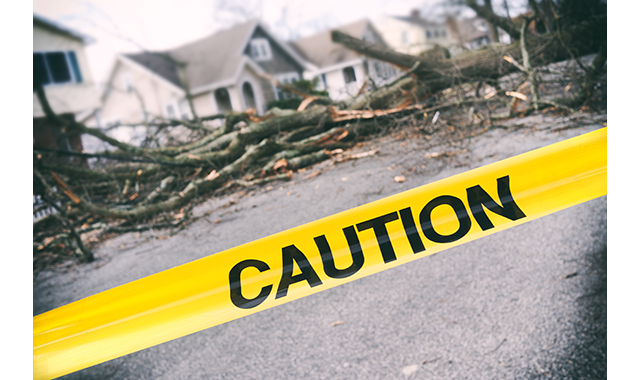Bouncing Back: How to get back on your feet following a disaster

The Boy Scouts have a famous motto: Be Prepared. While it may be hard to avoid a calamity-especially an act of God, like a hurricane or a tornadoÂ-bouncing back is easier to do if the practice has an emergency management plan in place. That plan will help organize such details as clean up, business loss, and even making sure that practice employees are taken care of.
Safety first
Restoring the practice to operational status is likely to be a huge task. Where would one even begin? The biggest ventures have logical beginnings.
“I always begin any project like that with the concept of safety in mind,” says Dr. Douglas Risk, DDS, who is the Compliance manager and a private practitioner at Tidewater Dental in Southern Maryland, serves on the Executive Board of Directors for OSAP, is a Diplomate of the American Board of General Dentistry, and is a Fellow of the International College of Dentists. “One of our offices burned down back in September, and getting started was pretty much all about safety. The first thing we did was check and see if the fire department and other authorities cleared the building and made sure that it wouldn’t fall down; swept the parking lot, making sure there were no nails or anything that’s going to injure someone from walking through the parking lot or give a car a flat tire.”
Checking that utilities like electric and water are turned off at the site is another main concern, as those could become a hazard if anyone enters the property, Dr. Risk adds. And access to the property will be limited during inspections and investigations by authorities.
But it isn’t just governmental authorities that will to be involved in any investigation. The insurance company needs to be aware of what’s going on, as well.
“The insurance company’s going to want to see the untouched building to gather evidence of what happened,” Dr. Risk says. “Where did the fire start? How far did it spread? If it’s a flood or a hurricane or something like that, is this a known flood zone or an unusual circumstance? And then they’re going to compare that to whatever policy happens to be in place, so that financial arrangements can be made; because you’re not going to be able to do a whole lot quickly until funds become available to put that machine into place.”
Dr. Risk recommends sorting through the site and organizing materials based on their status as trash, recyclable, or salvageable. When it comes to something like clinical equipment, its future serviceability is going to be influenced by what the insurance company decides.
“What does the insurance company say?” Dr. Risk says. “Salvage everything you can, because they may not pay to replace it, or are they going to be a little bit more liberal and say, ‘You know what, if you can’t get inside of that piece of equipment to check for mold or burnt wiring or any of that stuff, then we’re not even going to consider it salvageable, it has to be replaced,’” he says.
To that end, every piece of equipment would have to be inspected inside and out to determine the safety of salvaging each. This equipment can have hidden damage, Dr. Risk says, which can render a piece unsalvageable. He recommends having equipment inspected by a qualified professional to determine its safety for reuse after an event.
Continue reading on the next page...
Continuity
Obviously, if a practice suffers a catastrophe, it is going to take some time to get back up and running. Contingency planning-also known as disaster recovery or business continuity-are a must for any business needing to get back to operational status quickly, says Mary Bog-Bartlett, president of SafeLink Consulting.
“Any kind of disruption of your business, for a period of time, is stressful and can be financially disastrous,” Borg-Bartlett says. “Business owners who have developed a business continuity plan will be back in business much sooner than those who haven’t planned for the unexpected.”
Dental practices that have performed a HIPAA security risk assessment should be familiar with this type of planning, Borg-Bartlett adds, as there are several questions regarding a practice’s contingency plan.
Becoming operational again is critical for everyone including dentists, the staff, and the patients. From a business perspective, recovery involves providing patient care as soon as possible-even if that’s at another facility.
“Two of the most important first steps after a natural disaster are having access to the appointment schedule so patients can be called to alert them to the situation and having pre-arranged with a fellow dentist to use his/her facility temporarily to see patients,” Borg-Bartlett says. “There are companies that can be called to set-up a temporary practice in a mobile unit. One of my clients had to do that several years ago when their office was flooded. They were back in business very quickly.”

Contingency planning necessitates maintaining several inventories that help in understanding what the practice has on hand, including equipment, furnishings, and materials, Borg-Bartlett notes. This will help in providing the insurance company with a list of the lost items, but it will also provide a starting off point of items needed to reopen the practice.
“Another part of business continuity is to have a list of all the practice’s vendors, insurance companies, financial institutions, account numbers, passwords, etc. so they can be contacted immediately,” she points out.
But if all of those lists are kept at the practice, aren’t they at risk of being destroyed or lost? They are, and that’s where The Cloud is involved.
“Because of Cloud-based systems, the practice’s patient information can be accessed from all sorts of devices,” Borg-Bartlett says.” Make sure that usernames and passwords are retained where they are available in the event the practice is inaccessible.”
Continue reading on the next page...
Clean-up
From an infection control standpoint, clean-up, disinfection, and potential risks cannot be understated.
Mold is one of the main considerations after a flood of fire where water is involved, Dr. Risk says. Patients can be more susceptible to certain types of infections and mold can get into ductwork, heating and air conditioning, waterlines, and airlines, he adds.
“So, you’ve got a huge situation where even a little bit of water may be a big problem, because a lot of the inlets in the floor are susceptible to flooding. Any kind of contaminated debris that gets in there is very susceptible to proliferation, and you’ve got a big problem trying to decontaminate that or replace the ductwork, floors, carpeting, etc.”
Environmental factors can also complicate things, Dr. Risk says. Humidity plans a part, particularly in southern states where items can’t just be placed in the sun to dry out.
“I remember being involved with some floods and cleanup in Texas and Louisiana, and trying to get that that to dry out-even with the sun out-would continue to be moldy. So, it’s a difficult situation.”
Your insurance company will be helpful in determining if waterlines, ductwork, or carpeting need to be replaced. County health departments can be a good resource, too.
“The difficulty is that you’re probably not going to realize how contaminated some of that stuff is until a couple of weeks to a couple of months afterwards. Then, all of a sudden, people just get sick for no reason whatsoever. It makes it difficult,” Dr. Risk says.
In terms of clinical equipment, some items can be salvaged, cleaned up, disinfected, and returned to service while others may be a complete loss.
“Certainly, when you’re looking at instruments that you’re trying to salvage, again, you can’t inspect every piece of an instrument,” Dr. Risk says. “For instance, a handpiece has internal parts. We can put it into a handpiece maintenance machine and blow everything out, but do you actually have access to everything in that handpiece to
guarantee that it’s been completely decontaminated, or is it better just to throw that handpiece away? Once you’ve determined what you want to salvage, then you go back and say, ‘Okay, does this instrument look brand new?’ And if it doesn’t look brand new, I think we can consider it to be contaminated. So, any pitting or rusting that happens can happen in a matter of days, depending on the water.”
Obviously, your equipment-like your ultrasonics, instrument washing mechanisms, sterilizers, those types of things-have to be working 100 percent, like they were new,” he continues. “And a lot of times, if you talk to your insurance company about the criticality of those instruments, they’ll be on your side to be able to put together a package that says, ‘For instrument processing and sterilization, we want to make sure that everything is up to speed.’”
Testing of instruments and equipment should be conducted to ensure a safe environment, Borg-Bartlett adds.
“As far as infection control, it’s imperative that prior to opening a practice after this type of disaster that the water quality is confirmed to be safe before treating patients,” she says. ”This can be accomplished by testing the water. Also, the sterilization area must be completely stocked and operable with equipment, instruments, handpieces, tools, packaging, and chemicals.”
No matter what the disaster, it’s best to think like a Boy Scout and Be Prepared.
“They need to have planned for these types of events and have a plan in place,” Borg-Bartlett says. ” What they have to remember is that it’s not only their income that will stop, but also the income of the staff. If the dentist isn’t able to keep the staff working, they will find jobs elsewhere, so the sooner businesses can get up and running the better.”
Maximizing Value: The Hidden Benefits of Preventing Hospital-Acquired Pneumonia Through Oral Hygiene
September 10th 2024Originally posted on Infection Control Today. Hospital-acquired pneumonia (HAP) is a significant infection prevention concern, leading to high patient mortality, increased health care costs, and ICU usage. Oral hygiene is an effective preventive measure.